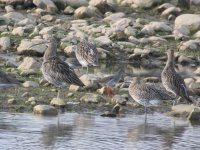Many will recommend that you don't use a DSLR for digiscoping, the main reason being that larger sensor cameras are more 'light-hungry' than compacts, meaning that faster shutter speeds are usually less easy to get unless conditions are bright. There is also the issue of mirror-slap causing vibrations-as you already know vibrations are the enemy of digiscoping. Even a little wind can cause problems, but if it's calm you should get some very useable results with practise. Either use the cable release, or 2 sec timer.
I started digiscoping several years ago with a compact with 3x zoom lens, but recently have started using a 550D like yours through an 80mm Swarovski. I use the DCA & not the UCA. Therefore our kit is basically very similar.
Firstly, a couple of general statemements. Your set up will be better for stationary subjects, or slower moving ones e.g. that are swimming left to right or vice versa. You can forget the idea of shooting anything fast moving or birds in flight! unless it is a distant large bird flying across the frame. Also you will need to manual focus the scope, though it might also be possible to use the camera's AF once the scope is focussed approximately, though watch that the lens doesn't collide with the eyepiece as the inner barrel moves out during focussing. It should be possible to set up the UCA to leave a space between the camera's lens & the eyepiece glass.
It might be better to switch the lens to manual focus only, to avoid any collisions, then just use the scope's focuser. You will find it easier (by far) to manual focus in live view mode. I always use AV mode, and mostly ISO400. If it is very bright you could lower this to ISO200, or go up to ISO800, or even higher if it is very dark. I'm not sure how well you know your camera's settings yet, but in live view it is possible to magnify the image before taking the shot, by either 5x or 10x. This allows you to really fine-tune the focus before pressing the shutter. It's probably an understatement to say that focussing is the single most tricky element in digiscoping, but with practice it gets easier. Use a coke can in the garden (or the living room!) to practise & really get to grips with this.
You might find this video helpful to get your kit set up:
http://www.youtube.com/watch?v=mRbVDSsrHyE
My general settings are:
ISO 400
F5.6 or wider (f4 etc) though there will be little to no gain in shutter speeds once the lens is 'opened up' past this point, as the aperture is limited by your scope
Use a cable release or self timer
For some reason when using the 50mm 1.8 I, I got some shots that were very over exposed. Expect to use perhaps a stop or more of EV compansation if you experience this. In some instances I had to under expose by 1.5 stops.
You didn't say which eyepiece you used on the scope. Mine is the 20-60 zoom, and I get no vignetting at any zoom level with a 50mm prime lens on the camera. I've also had some success with the new Canon 40mm STM lens, the Canon 50mm 1.8 I, and recently a Pentax legacy 55 f1.8. The latter was acquired cheaply (under £30) and can be attached to the DCA adapter via its metal filter threads. I wouldn't trust hanging a heavy DSLR from the DCA by the plastic filter threads on modern lenses, but the older lenses are built like tanks!
Something else to consider is video. I find the video possibilities of using a DSLR through your scope via a 50mm prime lens is often better than stills, especially if light levels are low. Obviously 20x is better for quality results, but I've certainly used it at higher mags with success. Start zooming the scope's eyepiece and just watch the shutter speeds drop when shooting stills!
Hope some of this was helpful, and welcome to BF by the way
Steve
A recent example below, not a work of art, but should give an idea of what to expect.
ISO400
Shutter speed, only 1/40 sec, hence why the moving Redshank's legs are a little blurred.
This was with the Pentax 55mm lens which is attached to the camera via an M42 to EOS adapter, available for under £10 from Amazon.
Birds were about 150m away




